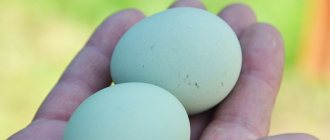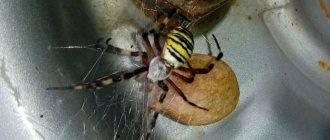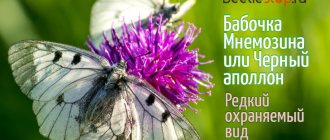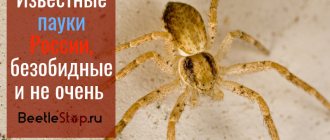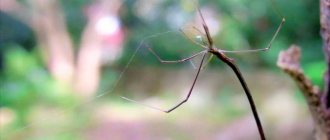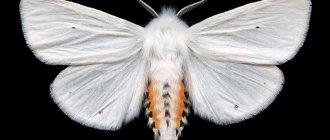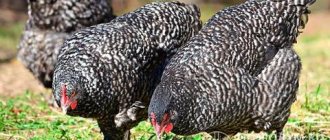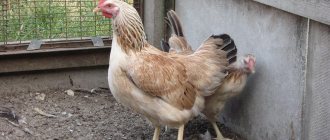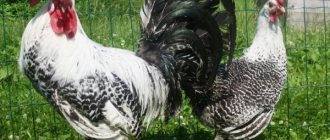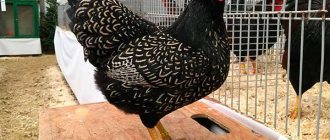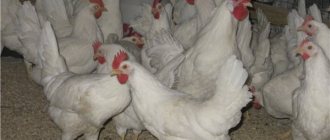Home » Domestic chickens » Crosses and breeds of chickens » Andalusian blue chicken breed
The meat-and-egg Andalusian breed of chickens is characterized by early maturing pullets, which begin to lay eggs at the age of about five months, laying three large white eggs per week or up to 160 eggs per year.
Breeds of blue chickens
Most of the known hybrids of blue chickens were bred by geneticists through numerous crossings of the best representatives among domestic birds. However, it is not so easy to understand that this is a blue chicken.
Regardless of the species, all chicks have similar external characteristics, so farmers have to wait until the first molt begins and full-fledged feathers of an adult bird grow instead of fluff. Often, breeders themselves cannot predict the exact number of representatives of blue breeds in the offspring.
We invite you to get acquainted with the six most popular breeds of blue chickens.
Blue Andalusian chickens
Breeders from Spain had a hand in creating this breed of blue chickens. By crossing black and white Minorok with blue fighting roosters, scientists have created a new species of blue chickens with unusual colors and high egg production rates.
Appearance of Andalusian Blue Chicken:
- the head and body are oblong, the forehead is convex;
- the crest is large, in roosters it is erect, slightly widened at its base, and in chickens it is tilted to the side;
- the earlobes are oval white, and the beak is dark gray;
- the head is red and the skin is white;
- amber eyes;
- paws are gray with a blue tint.
Adult chickens are evenly covered with gray-blue feathers, and in adult roosters the upper part of the body - the mane and back - has a darker shade.
Each feather is edged with a dark stripe, which gives the laying hens a particularly “elegant” appearance. This color is unstable, and in the offspring of Andalusian laying hens, only half of the chickens have a blue color, the rest have plumage with different shades of gray: from dirty white to almost black.
But they are not considered rejected for selection, because when chickens with such plumage are re-crossed, offspring with a beautiful blue color are obtained. On the first day of life, Andalusian Blue chickens are evenly covered with soft light yellow and gray down.
The weight of adult roosters is 2.5 kg, and that of chickens is 2.2 kg. The breed's egg production is 150-170 eggs, the average egg weight is 60 g, the shell color is white. Young laying hens begin laying eggs at the age of six months.
Due to its unique color and high egg production, this breed has gained a huge number of fans among poultry farmers from all over the world. In many nurseries, Andalusian blue chickens are kept by breeders to preserve the gene pool.
These pet birds are sensitive to sudden changes in temperature, drafts and cold air, so successfully breeding this breed requires creating optimal conditions in your nursery.
Blue chickens of Cochin
The Cochin breed is over 150 years old. Cochins bred by Chinese breeders have gained the greatest popularity among European poultry farmers. This is a meat breed, but is currently raised as an ornamental bird.
There are many plumage color options, the most popular being fawn, white, blue and spotted.
Exterior of Cochin:
- the body is rounded, the back is wide, slightly raised towards the tail, the chest is well developed;
- comb of small size, leaf-shaped;
- oval-shaped lobes, red;
- the beak is small, yellow in color, with a slightly downward end;
- eyes are deep set. Their color depends on the color of the plumage of chickens - fawn birds have amber eyes, and black birds have dark gray eyes;
- the legs are short, covered with feathers and widely set, yellow in color;
- the tail and wings are short, without long feathers even in males.
Adult Cochins are completely covered with loose and patchy plumage, even with feathers growing on their paws and toes. Such lush plumage gives adult individuals a spherical shape.
Representatives of this breed have a calm character and easily adapt to changing environments. The females incubate the eggs on their own, and after the birth of the offspring, they do not leave the chicks a single step.
Chicks go almost bald for the first few months of life; hens mature by the age of eight months.
The weight of adult roosters reaches 6-7 kg, and chickens weigh on average 3.5-4.5 kg. The breed's egg production is 110-120 eggs, with the largest number of eggs laid in winter. The average egg weight is 55 g, the shell color is rich brown.
There is another variety of these blue chickens - dwarf Cochins. Their only difference is their small size. The weight of adult individuals does not exceed 1 kg, egg production - 75-85 eggs, egg weight - 45 g.
Their unusual appearance, small size and ease of care have made the dwarf Cochin a favorite among other decorative pets.
Blue chickens of the Aurora breed
This breed is the result of many years of work and numerous selections by Russian scientists who tried to breed a breed of poultry with increased productivity and an unusual appearance.
In the process of creating Aurora, geneticists used various combinations of genes from Australorp chickens:
- males and females of Aurora Blue have dense plumage of light blue color with a dark border on each feather;
- in roosters, the upper part of the body has a darker color;
- the body is slightly elongated, the head of roosters is larger than that of laying hens;
- the eyes are brown, the beak is small light gray, the paws also have this color;
- It is interesting that both laying hens and roosters have large leaf-shaped red combs growing on their heads, and there are earrings at the bottom of the beak to match them.
The weight of an adult male is 2.5-3 kg, an adult laying hen is 2-2.5 kg. Egg production during the year is 200-220 eggs, the average weight of each egg does not exceed 60 g, the shell color is white. Puberty in laying hens begins at an early age - the first laying of eggs is possible as early as 4 months.
Egg production is consistently high in the first couple of years, after which experienced poultry farmers recommend replacing them with young animals.
Aurora’s character is calm and cautious; the birds take a long time to get used to people and do not like frequent changes in diet and living conditions; they are unpretentious in food. This hybrid does not have a pronounced brooding instinct. It is extremely rare to see a picture of the feathered mother Aurora walking her chickens.
Story
The Andalusian breed of chickens was first bred on the territory of the Spanish state at the beginning of the 19th century, after which it was transported to the countries of Great Britain and then to Germany.
It was German breeders who began to work closely on obtaining beautiful blue plumage in poultry and increasing their productivity. Andalusian chickens are the result of crossing the white and black Minoroc breeds with a fighting rooster, which has blue plumage.
Chickens have a calm and at the same time explosive character, testifying to their Spanish origin, fairly good productivity, the ability for which was borrowed from the Minor, and an unusually beautiful blue plumage, which the Andalusians inherited from their relative the fighting cock. Many poultry farmers also note the well-developed ability to fly aviaries.
Breeds of blue chickens
Selection and breeding under human control have led to the fact that many bird breeds are now improved not only from a productive, but also from an aesthetic point of view. Breed characteristics can be very diverse, including color and quality of plumage. There is a European register in which all officially recognized breeds of chickens are registered, the number of which includes several hundred species. Each breed has its own characteristic features, including color. Man has always strived to create the unusual; of course, one of such original creations is blue chickens. The selection of such species is not only aesthetically pleasing, but also commercially profitable.
Advantages and disadvantages
The description of this breed includes several advantages:
- high decorative qualities;
- relatively good egg production;
- good survival rate in chicks is about 93%, in adults - 87%;
- Great taste of meat and eggs.
It has several disadvantages:
- the desire to hatch chicks and further maternal instinct are poorly developed, so incubators are often used for breeding poultry;
- deformation of the ridge, which leads to loss of decorative appearance;
- the breed is very rare and expensive - a week-old chick costs about 300, a two-week-old 350, a hatching egg - 200 rubles;
- afraid of cold and sudden temperature changes.
general information
It must be immediately recognized that the decorative purpose is far from the most important; breeds of blue chickens lay eggs well, many of them are bred for meat and egg purposes. And here the exotic already fades into the background, productivity is more important. The most common laying hens can be blue in color. But there are also breeds that were specially bred in this coloring. It should be noted that at birth, color is not always determined absolutely accurately. Similar signs appear after the young animals reach about 2 months of age. Chicks fledge as adults, and then the congenital trait becomes obvious.
There are main categories into which chicken breeds are divided:
Each of them has blue representatives. They are similar only in one thing - the exotic type of plumage, everything else (life expectancy, character, temperament, egg color) differs. There are a lot of blue chickens bred through selective breeding. We offer you a description of the most popular varieties.
External signs
Gallant cockerels weigh about 4 kg, and chickens up to 3.5 kg. The main breed characteristic is the presence of a beard, and in individuals of both sexes. The beard is wide, arched. Large, well-developed head with a wide but short beak. The earrings and rose-shaped comb (without a spike) are colored pink.
The neck is of medium length with a rather deep curve, slightly thinner in the area where it meets the shoulders. The body is large, with a wide back and chest. The tail is moderately developed, but roosters have very long braids. It is slightly raised and is located at a right angle to the body.
The face of these feathered beauties is deep red, and large brown eyes stand out on it. The paws and legs are very powerful and muscular. The color of such chickens is always black, and the feathers of roosters have a greenish tint. Warm and thick coats of feathers make birds incredibly resistant to cold and frost.
In general, they are harmoniously built and look incredibly elegant! They move importantly and smoothly, like peacocks. Unfortunately, today the Galan breed of chickens has become a rare bird in Russia, even despite its Russian roots
Finding it on sale is quite difficult, especially in its pure form.
Unfortunately, today the Galan breed of chickens has become a rare bird in Russia, even despite its Russian roots. Finding it on sale is quite difficult, especially in its pure form.
Even if the parent chicks fully correspond to the description, in the next generation the gene of other breeds may appear, and then the chicks are subject to culling.
Popular individuals
Andalusian breed
This bird is primarily an egg-laying bird. It was bred, as the name suggests, in Spain. Minorca chickens were used as selection objects. Andalusians are excellent layers, they are distinguished by a high degree of decorativeness, and they are very beautiful. The blue color of each feather is decorated with a spectacular border of a shade darker than the general one. All this creates an incredible impression of the bird. This type of chicken gained the greatest popularity in its homeland. Despite the fact that Russian poultry farmers would like to breed this breed, this is difficult to do due to the heat-loving nature of the individuals. The harsh climate of our country does not suit her.
Characteristic features of the breed:
- a high degree of egg production, and this process does not stop throughout the year, however, in the winter it is necessary to maintain comfortable living conditions;
- not too strong immunity, low survival rate, lack of resistance to diseases, any draft, cold, temperature changes can lead to diseases;
- The brooding instinct is very weak, females are not very caring, so keeping and breeding chickens will require special treatment.
Cochin chickens
These are quite large representatives of the feathered tribe, they are quite active and lively. They were developed in China, but now they are distributed throughout the world. They are distinguished by a huge number of color options, including blue. However, other external features are extremely similar. This breed is a decorative species, although meat is also eaten. Features of this breed:
- very large size and weight of the bird, minimum – 5 kg;
- underdeveloped egg production, small eggs;
- roosters and hens are distinguished by their tall stature, powerful build, and well-developed muscles;
- the plumage is very lush, including limbs and fingers;
- shortened, stubby tail, regardless of gender;
- puberty and the ability to reproduce occurs after 8 months;
- chickens take a very long time to fledge;
- weight and size grow very quickly;
- females hatch chicks quite well, they are very caring.
Russian breed (Aurora)
Of course, when breeding blue chickens, the exterior is of great importance. The domestic representative of birds of this color stands out for its spectacular appearance. She received recognition not only in Russia, but also abroad. In addition to their attractive appearance, chickens of this breed are very resistant to difficult climates and frosts. Its high productivity makes it very attractive for breeding. Features of the Russian breed:
- the main direction in breeding is egg production;
- puberty is early, so keeping chickens is quite cost-effective;
- already at 5 months she brings her first eggs; with proper care, she brings more than 200 eggs per year, the weight of the eggs is up to 62 grams;
- the average weight of chickens is from 2 to 3 kg, the taste of the meat is good;
- the disadvantage of the breed is that of the two chickens born, one does not inherit the characteristic characteristics of the parents, therefore this breed is often not distinguished as a separate one;
- the disposition is benevolent, calm, friendly, however, birds of this breed have a very anxious character, they get scared easily and are not very stress-resistant.
stroy-podskazka.ru
Features of feeding
Proper feeding is the key to successful breeding of any breed of chicken. Keeping chickens producing meat and eggs requires strict adherence to a certain diet. Considering that chickens begin to lay eggs early, and egg production is quite high, they need large quantities of protein and calcium for the successful formation of eggs. If birds are not provided with optimally balanced nutrition, they can get sick and even die. However, quality should not be replaced by quantity: overeating has a bad effect on the health of laying hens and significantly reduces egg production, and if there is a lack of food, hens even stop laying eggs. During the laying period, one hen needs from 115 to 125 g of feed and grain supplements per day. It takes a laying hen only 1 day to form one egg.
Tetra chickens grazing
Advice from experienced poultry farmers regarding the diet of Tetra chickens
- It is imperative, especially in the evening, to give the birds wheat, millet, corn and barley: the percentage of cereals can be varied;
- bowls with ground shell rock and chalk should be placed in visible places in the chicken coop and constantly replenished: these ingredients prevent blockage and inflammation of the goiter;
- to enhance nutritional value, you need to add industrial premixes to the feed;
- sprouted wheat is very useful for chickens: it is rich in vitamins and beneficial microelements;
- roasted barley helps to increase the weight of birds and increases egg production;
- charcoal and apple cider vinegar have a positive effect on the digestive system.
Apple cider vinegar speeds up feather growth in chickens
Every day a chicken needs 250 ml of water. You can quench the thirst of birds not only with the help of clean drinking water, but also by preparing a weak solution of potassium permanganate, adding 3 grains of the substance to 1 liter of liquid. With this simple remedy you can protect birds from many infectious diseases.
What to feed chickens?
Adequate nutrition is the main condition for high productivity of laying hens and rapid weight gain in broilers. Regardless of the purpose for which you raise birds, the diet must be properly organized, varied and balanced. Read our article on how to ensure proper feeding for your birds.
To feed Tetra chickens, you can use the following feed recipe.
| Product name | Quantity, g |
| corn | 450 |
| wheat | 120 |
| barley | 70 |
| sunflower meal | 70 |
| chalk | 70 |
| meat and bone meal | 60 |
| fish meal | 50 |
| feed yeast | 40 |
| grass flour | 30 |
| peas | 20 |
| vitamins | 10 |
| salt | 3 |
0.1 kg of this nutritional mixture contains 268 kcal, while it consists of 17% protein.
100 g of this mixture contains 17% protein
The diet of chicks of this breed is similar to the feeding system of babies of other varieties. In addition, Tetra chickens are very strong and resilient. To prevent diseases and support fragile organisms, it is advisable to feed foods high in vitamins.
To raise one chicken, 6 to 7 kg of feed is required
Features of hybrid chickens
This variety of birds was developed by crossing the most productive purebred breeds. They were created with the aim of increasing productive characteristics. In addition, work was carried out to create calm and friendly individuals, which is beneficial for cage keeping. In the table below you can explore the advantages and disadvantages of hybrid and purebred chickens.
The best representatives of hybrids can lay eggs almost every day
| Hybrid | Purebred | |
| Advantages | They show good egg production already at 1 year of age. | Able to lay eggs for a longer period. |
| Egg production in the first 12 months of laying is much more predictable. | They live longer. | |
| They lay eggs even in winter. | Laying hens are excellent brood hens. | |
| Early puberty promotes early egg laying. | Intensive egg laying has virtually no effect on health. | |
| They are calm in nature, easy to manage and friendly. | Better suited for free keeping. | |
| Cheaper in cost. | ||
| Flaws | Egg production rates after the first year of laying are difficult to predict. | It is difficult to predict egg production. |
| Shorter lifespan. | In winter, egg production drops significantly. | |
| The only way to update the population is to buy new females. | Slow puberty. | |
| Sometimes they lay eggs with fragile, thin shells. | New layers do not lay eggs until spring. | |
| They require more feed. | Light breeds are “character-filled”, while heavy breeds are apathetic. | |
| More expensive in cost. |
Some purebred varieties do not maintain the purity of the breed due to the widespread occurrence of hybrids.
Breeds of blue laying hens with descriptions, photos and videos
Author: Chicken Ryaba
Hello, dear readers! Everyone knows about the existence of various colors of chickens, and many prefer to choose not just hard workers, but also those that have decorative qualities. Breeds of blue laying hens with descriptions, photos and videos in our material. Blue chickens are one of the most unusual and attractive.
Today we will look at those breeds that have this shade of feathers. It should be noted that there are many more such beauties, but we will consider only 6 of the most popular.
The photo shows blue Dominant hens, read the link for more details about these super laying hens!
Nuances of breeding
Breeding in a chicken coop is very rare, so breeders use incubators.
An important condition for successful hatching is a selection of high-quality eggs. Only fresh ones are selected (not older than 5 days) without cracks, with a flat and smooth surface. It is better to use medium-sized instances
It is better to use medium-sized specimens.
The fertilization of eggs is quite high - about 95%. After laying and until the brood appears, a certain regime is maintained in the incubator - in the first 7 days 40°C, all subsequent weeks are lowered by 1°C. During incubation, the eggs are turned daily 3-4 times a day.
Hatched chicks are kept in a dry box at a temperature of 25°C with diffuse daylight.
Feeding young animals
Feeding begins after the fluff dries, when the chickens become active. The first dish is a boiled and chopped chicken egg.
From the third day of life they are fed cottage cheese, small greens and cereals. Juveniles eat frequently, so they need to be fed at least five times a day.
Up to three weeks of age, chicks require a large amount of protein, which strengthens bone tissue and prevents the development of rickets - minerals, fermented milk products, fish oil, and yeast are introduced into the diet. Additionally, coarse-grained, pre-calcined sand is provided.
To strengthen the immune system and increase activity, glucose (5%) is given instead of water for the first 3 days. All subsequent days offer clean, fresh water at room temperature.
Features of care
The main care for chicks is to ensure a stable temperature within 25-27°C, good lighting for at least 10 hours a day.
Sawdust or straw is used as flooring in the box, which is changed every five days. On sunny days they can be walked in the fresh air.
Starting from 2 weeks, chickens are transferred to an adult diet - they are given crushed feed. From the age of two months, young animals begin to be kept in a common herd.
https://pro-kur.ru/andaluzskaya-golubaya-poroda-kur/https://selo.guru/ptitsa/kury/porody/myaso-yaichnye/andaluzskaya-golubaya.htmlhttps://fermoved.ru/kuryi/ andaluzskaya-golubaja.html
Breeds of blue laying hens
It should be noted that such blue chickens are not only decorative and exotic representatives of the bird world. Ordinary working women, egg, meat and combined types, may also have this color. Many breeds of blue laying hens were obtained thanks to the efforts of breeders, and are presented not only in this color.
From the first days of a chick's life, it is not always possible to determine the color, so babies do not yet have such pronounced signs. But, by about 1.5-2 months, when the cubs acquire adult feathers, it becomes clear what color their fur coats are.
So, let's look at the most popular representatives with a characteristic shade of feathers. If you are interested in reading the full description of the breed of blue laying hens, then follow the links to a brief review, there are many photos, videos and reviews from breeders.
Feeding
Chickens of this breed are fed with compound feed for laying hens (PK-1). Consumption 120 g per 1 individual per day. After the start of egg laying, hens should have crushed shells freely available.
Chickens are fed with special complete feed for young animals (PK-2) every 2 hours. With age, the frequency of feedings is reduced.
- Stern
- Recipes
- Supplements
Compound feed pk-1
Description of food for egg breeds. Instructions for feeding laying hens
Read
Compound feed pk-2 and pk-3
Mineral and vitamin compositions, feeding standards
Read
Compound feed pk-4
Used to feed laying hens aged 15-17 weeks
Read
Compound feed pk-5
Composition and instructions for feeding broiler chickens
Read
Purina Pro
Important differences from the previous line, application patterns Start, Growth, Finish
Read
Barley and wheat for laying hens
Germination and steaming of barley and wheat for chickens: how to do it correctly and how to give it to laying hens
Read
Wheat for broilers
Rules for feeding broiler chickens with wheat. Dosage for chickens from the second day of life and adult birds
Read
Mash
Making mash for broilers at home
Read
Rice and buckwheat
How and in what form you can use rice and buckwheat to feed chickens. Standards for adult birds and chickens
Read
Bread
What kind of bread can you feed chickens and how to do it correctly
Read
Fish
The product is given in limited quantities: overfeeding can cause serious harm to the bird Contents
Read
Chalk
Chalk as a food additive for chicken feed. Feeding standards for chickens, young animals and laying hens
Read
Meat and bone meal
Meat and bone meal is a mandatory additive for feeding chickens, containing protein and fats of animal origin.
Read
Fish fat
How to give fish oil to chickens, layers and broilers. What are the benefits of the drug and are there any contraindications?
Read
Limestone
Limestone (dolomite) flour in the diet of chickens. Advantage over chalk and feed shell
Read
Salt
Daily dosage of salt for adult birds and young animals and cases of unwanted use
Read
TOP 6 blue chickens
Blue Andalusian chickens
The chicken belongs to the egg-laying direction. The feathered beauty was first obtained in Spain, and in order to breed it, breeders used Minoroc. Andalusians are not only good layers, but also incredible beauties - each feather with a characteristic color has a darker border, making them look unique.
Today, Andalusian beauties are widespread mainly in their homeland. In our latitudes there are many fans of Spanish flu, but, unfortunately, the local climate is not suitable for it. Let's consider several features of this layer.
- They cope well with the task of egg production, and can not stop laying even in winter, but provided that the optimal air temperature in the house is maintained.
- Andalusian has poor survival rates and is susceptible to drafts, temperature changes, and increased air humidity - this complicates the maintenance process.
- In addition, Spanish beauties rarely become good mothers - during the selection process they lost the brooding instinct.
Blue chickens Cochin
Large, lively birds with an interesting character - Cochin. They are considered an achievement of Chinese breeders, but today they have become popular all over the world. Cochins come in a variety of colors.
But, they all have extraordinary external characteristics, and therefore are considered more decorative than a meat variety. What makes them special?
- Very large - about 5-7 kg of live weight. But, at the same time, they lay weakly, and the eggs do not turn out large.
- Tall, large, with powerful muscles, which are emphasized by a lush feather coat. Even the paws and fingertips are covered with feathers. The tail is short and stubby, even in roosters.
- A significant disadvantage of Cochins is that the chicks fledge for a very long time, and the pullets mature closer to the 8th month of life.
- Because of this, representatives of both sexes gain weight at a rapid pace and grow to incredible sizes.
- Fluffy giantesses can hatch chicks on their own - this instinct is inherent in them by nature itself. After the birth of squeaky cubs, they become caring mothers for them.
Incubation
Andalusian blue chicks are bred in regular incubators. The incubation period is 21 days.
Table of temperature and humidity modes
| Period | Deadlines | ️°C | % | Turns | Ventilation | Ovoscopy |
| First | 12-16 hours | 38,5-39,0 | 75-85 | |||
| Second | 16-48 hours | 37,8 | 75-85 | 6-10 per day | ||
| Third | 3-6 day | 37,8 | 70-75 | 6 -10 per day | Twice 5 minutes | Conducted on day 6 |
| Fourth | 7-10 day | 37,8 | 65 | 6-10 per day | Twice 5 minutes | Conducted on day 10 |
| Fifth | 1-14 day | 37,8 | 50-55 | 6-10 per day | Twice 10 minutes | |
| Sixth | 15-19 days | 37,5-37,6 | 50-55 | 6-10 per day | 3 times 10 minutes | Conducted on day 19 |
| Seventh | 20-21 days | 37,5 | 65-70 | Twice 5 minutes |
Chick development by day. Signs of correct and incorrect development of the embryo Read
How to choose the right eggs to put in the incubator? Answer
Brooders for chickens in different price segments. For hobbyists, farmers and industry Top – 9
Review of industrial and amateur incubators for breeding chickens Top - 15
Legendary Leghorn
Almost all varieties of modern breeding egg-laying crosses were created using the genetic heritage of the famous Leghorn (Italian: Livorno; English: Leghorn), which already existed in the 19th century.
Despite such a “young” origin, this family is still quite common, therefore it can deservedly be classified as the most fertile type - each hen of this tribe is capable of laying 300 eggs per year.
Egg breeds of laying hens. They are so different!
It is known that the founders of the dynasty were “dressed up” only in snow-white plumage, but at the moment their “wardrobe” has been replenished with outfits from cuckoo-partridge and golden to brown and spotted variations.
But more important and extremely useful in this matter is the peculiarity of the “colored British” - they differ in the colors of girls and boys even at the age of chicks, which makes it possible to quickly begin the necessary sorting of offspring
The Andalusian chicken is on the verge of extinction
The fantastic color of the bird makes everyone fall in love with it. But the very first offspring that an inexperienced farmer receives is unpleasantly surprising: only half of the chickens will be pale blue. The remaining birds have black and white plumage with dark spots. But don’t be scared and discard unsightly chickens. This result is predictable and explained by simple genetics.
Andalusian blue chicken
The Andalusian blue chicken simultaneously has two genes: blue and black. When such birds give birth to offspring, according to the laws of genetics, they turn out to be diverse:
- half will carry both genes,
- a quarter - only the black color gene - these are absolutely black birds,
- a quarter - only the gene for blue coloring - these are light ones interspersed with chicken, the so-called “splash”.
If you cross birds of the last two colors with each other, then absolutely all the chicks will turn out to be bright blue. For a farmer who is interested in obtaining and breeding beautiful Andalusian birds, it is useful to have a table of the colors of the chicks:
As can be seen from the table, the danger of complete extinction of the Andalusian blue chicken is slightly exaggerated. It is absolutely impossible to get chicks with a beautiful blue coloring only by crossing two black or two light Andalusian birds with each other. In other cases, pleasing blue chickens will appear. Of course, dark or light hens cannot participate in exhibitions, but it is quite possible to get beautiful purebred offspring from them.
In order to avoid unwanted crossbreeding, at the time of obtaining eggs for the incubator, you can simply seat the birds in several groups or separate roosters of unnecessary color.
Color variant of the Andalusian blue chicken
How they appeared
Andalusian chickens were first bred in Spain. Breeders wanted to get chickens not only with excellent productivity indicators, but also with a beautiful appearance.
Blue fighting males were used as an experiment. Subsequently, crossings were carried out within the already obtained individuals.
The blue breed has always been considered rare. At first, they were purchased only by experts in the field of poultry farming.
After some time, the birds were moved by egg-laying and meat-laying crosses.
Today this species can be found in breeding houses or among professional farmers who raise birds for exhibitions.
Content Rules
Poultry house
Birds should be kept in a dry, spacious and warm room with good ventilation and no drafts. The calculation of space is carried out as follows - at least 1 m² is allocated for 2-3 individuals.
If the area is smaller, the risk of developing diseases and parasites is high. At a lower density they will freeze in the chicken coop.
The bottom of the floor is covered with sheets of tin to eliminate the possibility of rodents entering. It is then whitened with slaked lime to prevent fungal infections. A thick layer of straw, dry peat or large sawdust is laid on top.
The laying of the flooring is carried out in dry and sunny weather, otherwise it will become saturated with dampness and can quickly become moldy. The litter is changed no more than once a year.
Chicken droppings and feathers that fall on the floor help maintain the desired humidity in the room.
To eliminate the risk of injury, adults are given perches that are not too high - up to 50 cm from the floor surface.
Ventilation and lighting
It is important to provide good lighting for 12-13 hours a day. The lighting should not be too bright or dim. Diffused daylight, which can be created using lamps, is suitable.
The second important condition is good ventilation. The room is ventilated daily by opening the window, doors or lid, depending on the type of structure.
In the absence of air exchange, there is a high risk of the development of pathogenic bacteria and microbes in a musty chicken coop.
The optimal temperature for keeping chickens is about 25°C. There should be no drafts, which contribute to sudden temperature changes and cause colds in birds.
Walking area
The chicken is kept in a confined space
The description of the Andalusian blue breed of chickens includes good productivity, subject to daily walking. Therefore, you need to take care in advance of a place for hens and roosters to walk.
The walking area is fenced with a high fence and a net is placed on top, since this bird is capable of flying high. The soil is sown with cereal grass in order to provide the chickens with green food for the summer in the future.
Due to their increased aggression and temperament, it is not recommended to keep them with other breeds. Frequent fighting can lead to injury and reduced productivity of both varieties.
Feeding ration
It is necessary to install feeders and drinkers in the chicken coop that are convenient and accessible to each individual. This breed has a good appetite and willingly eats any food. The diet includes:
- grain crops;
- weeds;
- industrial feed;
- leftover food from the table;
- wet mash prepared in fish or meat broth with the addition of vegetables and cereals, served warm.
In the summer, the amount of greens is increased, reducing the amount of grain and other feed in the winter diet. To increase egg production in the off-season, chickens are given sprouted wheat, barley, and rye. This feeding contains many vitamins and minerals. Additionally, laying hens are given gravel, shell rock, sunflower cake, legumes, fish and meat and bone meal.
The water in drinking bowls needs to be changed daily, especially if it is a simple container with an open top. It must be fresh and clean.
For convenience, many breeders use nipple or groove designs, in which the liquid remains of high quality longer.
Chickens
In general, exotic offspring are practically no different from ordinary ones. Spanish cubs are born in the same way as others - after 3 weeks. They are light in weight, about 40 grams, and their body is covered with fluffy, short gray hair.
There are also no specific rules for growing them - everything happens according to the standard scheme.
Read the list of the most basic feeding and care rules below.
- For 3 weeks after birth, chicks need to adhere to a strict feeding regime, because their growth and development depend on this.
- The first foods allowed to babies are cereals, greens and boiled eggs.
- It is important to enrich the menu with protein foods to avoid growth defects. For the same purpose, it is necessary to add minerals, especially calcium, which is involved in the process of bone tissue growth and skeleton formation.
- From the first days of life you need to improve your health. For strong immunity, chicks need fermented milk products, yeast, fish oil, glucose and vitamins, especially ascorbic acid.
- While small pebbles can be given to adult birds to improve digestion, they are not the right size for chickens. Instead, prepare a container for them with coarse sand, which must first be disinfected by heating it in a frying pan.
Where can I buy in Russia?
- You can buy chickens, hatching eggs and even ready-made carcasses of Andalusian blue chickens at the Kurkurovo . It is located at Moscow region, Lukhovitsky district, Kurovo village, 33. You can also see chickens of other breeds there. You can find out the current cost and availability of birds by phone.
- This breed of chicken can also be purchased at the private farm “ Veselaya Ryaba ”. It is located in the city of Kurgan at Omskaya Street, 144. You can find out the current cost of hatching eggs and day-old chicks by phone.
- Bird Village sells hatching eggs of the Andalusian blue breed . The farm is located in the Yaroslavl region, 140 km from Moscow. You can find out more information about the availability of eggs by phone.
Maternal instinct
Despite the fact that the described chicken has a number of good qualities, it also has disadvantages that breeders must take into account. The fact is that the feathered Spanish Andalusian blue breed of chickens is not able to be a good mother. Probably, during the selection process, a genetic failure occurred, which is why the beautiful quonka lost its instinct to incubate.
But, in this matter, an incubator can help out - if you follow the basic rules, you can get healthy offspring without involving a hen. Of course, there are times when it is not possible to run an incubator, or there are not a lot of eggs, and this does not make sense. In such situations, you can place hatching eggs under another hen, which can replace their own mother both in the process of incubation and in “raising”
Flaws
- The Andalusian blue chicken breed is expensive and rare.
- The brooding instinct is weakened.
- Sensitivity to cold.
That's all that can be said about the decorative quotation from sunny Spain. Let your friends also learn about this interesting bird - share the link to the article with them on social networks.
Don't miss out on new items - subscribe to site updates to be the first to read the latest publications.
Good luck to you, all the best!
Did you like our tips? Share with friends on social media. networks!
Uniqueness of the crest
Since this unique “hat” is the main “highlight” of Dutch chickens and a decisive factor in determining the purity of the breed, it would be appropriate to pay special attention to it. So, Dutch crested cats, whose breed is not “diluted” by any other, have a huge and snow-white crest
Pay attention to this when buying chicken, since the productivity of eggs and meat depends on the purity of the breed
So, Dutch crested cats, whose breed is not “diluted” by any other, have a huge and snow-white crest
Pay attention to this when buying chicken, since the productivity of eggs and meat depends on the purity of the breed
For years, a debate has been going on among breeders of Dutch crested birds: whether it is worth periodically cutting the crest of a chicken, giving it a more neat and well-groomed appearance.
One part of the opponents is inclined to think that shearing is mandatory, because it will not allow the “cap” to grow too large and create some discomfort for the chicken (for example, covering the eyes); the other is sure that nature itself took care of the bird’s comfort and there is no need for humans to interfere with this plan.
As for maintaining the snow-white tuft, everyone agrees: it is imperative to wash it. To ensure that the color does not “lose” - once a week.
And if such a procedure seems too frequent for the bird or for the owner, then bathe your corydalis as the “hair” gets dirty. True, in this case the crest will not be distinguished by its dazzling whiteness.
If you decide to breed a Dutch white-crested chicken, you will provide yourself with sufficient eggs, tasty meat, and, undoubtedly, decorate your yard with chickens of unusual appearance.
But, before breeding a “Dutch”, create the appropriate conditions for chickens of this breed:
- Separate insulated, dry and clean chicken coop.
- Minimum “communication” with chickens of other breeds.
- Give them the opportunity to walk freely as often as possible. That is, the fenced walking area should be as large as possible.
- Remember that Dutch white-crested chickens have a very weak immune system. If one individual gets sick, then it is necessary to urgently take all measures so that the others do not become infected.
- When purchasing chickens of this breed, make sure that the crest of the chickens is large and snow-white. If it is not possible to see the birds in person, ask the seller for a photograph and check the reputation of the selling farm.
Diseases
The Andalusian breed of chickens has good immunity against diseases; only when the conditions of detention are violated, with high humidity, dampness and cold, they suffer from colds.
To maintain the health of adults and young individuals, it is necessary to maintain these indicators at the required level. Young animals are vaccinated at an early age.
During the molting period, birds develop vitamin deficiency, so the diet should be especially rich and balanced.
Characteristics
The average live weight of chickens reaches 2 kg, and that of roosters – 2.5 kg. This breed of chicken can produce up to 180 eggs in its first year of production. Moreover, the eggs are quite large: their weight almost reaches 60 g.
Chickens reach sexual maturity at the age of six months, so they have time to lay a lot of eggs. On average, the survival rate of young animals is 93%, and of adults – 87%.
The winged Spaniards are special not only for their appearance, but also for their disposition. The Andalusian blue breed of chickens has a capricious character. These blackbirds are leisurely, but can be aggressive if necessary.
Chickens are not afraid of people - they easily make contact, but they are unlikely to be able to get along with birds of other species. They adapt well to new terrain and changing conditions, although at first they may experience a little stress.
Olive Eggers
These chickens are famous for having two genes - blue and dark, due to which they can produce eggs ranging from olive to greenish in color.
Eggers is not a breed, it is a hybrid.
The bird does not require special care; it eats almost everything. The main distinguishing feature of the hybrid is its lush plumage. The color of chickens can be brown, dark gray or even gray-black.
The limbs are high, bare, four-fingered. The body of the bird is massive with a bushy tail. The earrings, beard and comb are characterized by a bright scarlet color.
Olive Eggers produces up to 200 chicken eggs per year. The average weight of one egg is about 65 grams. A fairly strong shell is characterized by a blue color. The breed is especially valuable due to its meat, which has excellent taste characteristics.
